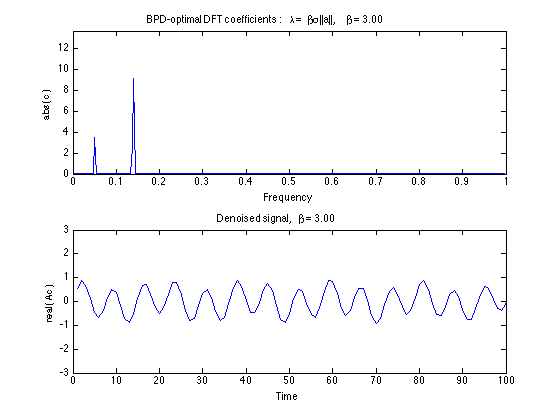Example: Basis pursuit denoising (BPD) with the DFT (with complex data)
Estimation of complex sinusoids in complex white Gaussian noise
Contents
Misc
clear
close all
I = sqrt(-1);
Make signal
N = 100; % N : signal length n = 0:N-1; f1 = 0.05; f2 = 0.14; s = 0.5*exp(I*2*pi*f1*n) + exp(I*(2*pi*f2*n - pi/3)); % s : complex sinusoid figure(1) clf plot(n, real(s), n, imag(s), 'r') legend('real','imag') title('Noise-free signal [s]')
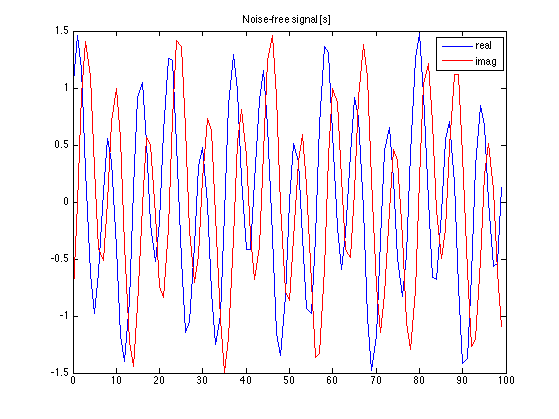
Define transform
Oversampled DFT
Nfft = 256;
[A, AH, normA] = MakeTransforms('DFT', N, Nfft);
Reconstruction error = 0.000000 Energy ratio = 1.000000
Make noisy data
sigma = 1; randn('state', 1); % set state for reproducibility of example y = s + sigma * (randn(size(s)) + sqrt(-1)*randn(size(s))) / sqrt(2); f = (0:Nfft-1)/Nfft; % f : frequency axis figure(1) clf subplot(2, 1, 1) plot(n, real(y), n, imag(y), 'r') legend('real','imag') title('Noisy data [y]') subplot(2, 1, 2) plot(f, abs( AH(y) )) title('DFT of noisy data') ylabel('abs( A^H y )') xlabel('Frequency')
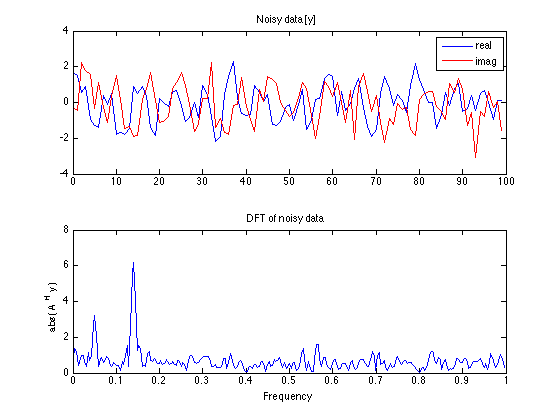
Solve BPD problem
beta = 3; lam = beta * sigma * normA; mu = 0.1; Nit = 100; [c, cost] = BPD(y, A, AH, lam, mu, Nit); x = A(c); % Display cost function history to observe convergence of algorithm. figure(1) clf plot(cost) title('Cost function history') xlabel('Iteration')
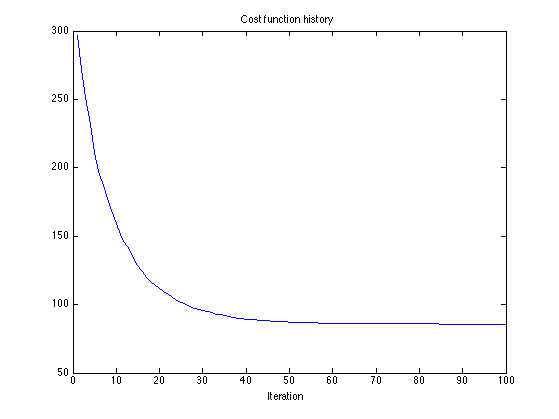
Display denoised signal
figure(1) clf subplot(2, 1, 1) plot(n, real(x), n, imag(x), 'r') legend('real','imag') title('Denoised signal') ylabel('Ac') subplot(2, 1, 2) plot(f, abs(c), '.-') title(sprintf('BPD DFT coefficients (beta = %.2f)', beta)); ylabel('abs( c )') xlabel('Frequency')
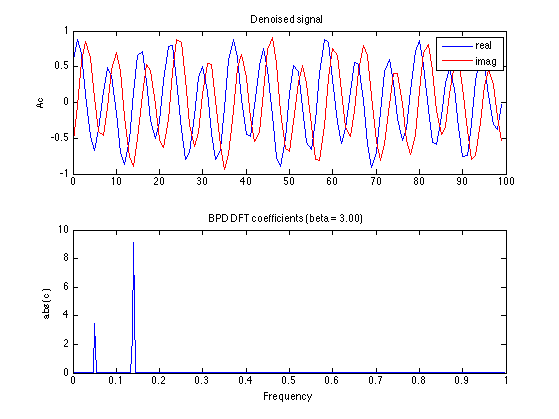
Optimality scatter plot
g = (1/lam) * AH(y - A(c)) .* exp(-I*angle(c)); cmax = max(abs(c)); figure(2) clf plot3( real(g), imag(g), abs(c), '.') zlabel('abs( c )') xlabel('Re(A^H(y - A c) e^{-j\anglec})/\lambda') ylabel('Im(A^H(y - A c) e^{-j\anglec})/\lambda') title('Optimality scatter plot') grid off theta = linspace(0, 2*pi, 200); line( cos(theta), sin(theta), 'color', [1 1 1]*0.5) line([1 1], [0 0], [0 cmax], 'color', [1 1 1]*0.5) xm = 1.2; xlim([-1 1]*xm) ylim([-1 1]*xm) line([-1 1]*xm, [1 1]*xm, 'color', 'black') line([1 1]*xm, [-1 1]*xm, 'color', 'black') box off % Animate: vary view orientation az = -36; for el = [40:-1:5] view([az el]) drawnow end for az = [-36:-3] view([az el]) drawnow end

Save figure to file
figure(3) clf subplot(4, 1, 1) plot(real(y)) title('Noisy data'); ylabel('real( y )') xlabel('Time') ylim([-3 3]) subplot(4, 1, 2) plot(f, abs(AH(y) )) title('DFT of noisy data'); ylabel('abs( A^H y )') xlabel('Frequency') subplot(4, 1, 3) plot(f, abs(c), '.-') title(sprintf('BPD DFT coefficients (beta = %.2f)', beta)); ylabel('abs( c )') xlabel('Frequency') subplot(4, 1, 4) plot(n, real(A(c))) title('Denoised data'); ylabel('real( Ac )') xlabel('Time') ylim([-3 3]) % print figure to pdf file orient tall print -dpdf figures/BPD_example_dft_cplx
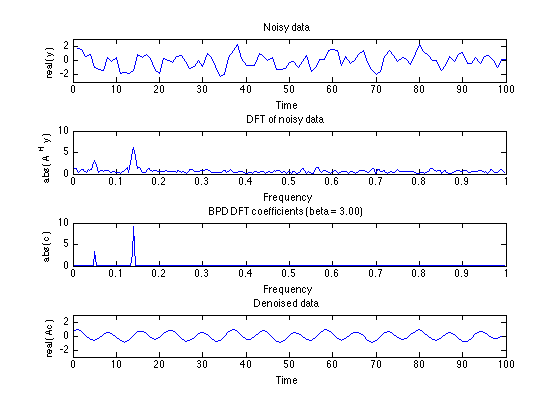
Animate: vary lambda
for beta = 0.1:0.05:3 lam = beta *sigma * normA; [c, cost] = BPD(y, A, AH, lam, mu, Nit); x = A(c); figure(10) clf subplot(2, 1, 1) plot(f, abs(c), '.-') xlim([0 1]) ylim([0 1.5*cmax]) title(sprintf('BPD-optimal DFT coefficients : \\lambda = \\beta\\sigma ||a||, \\beta = %.2f', beta)); % title(sprintf('\\beta = %.2f; \\lambda = \\beta \\sigma ||a||', beta)); ylabel('abs( c )') xlabel('Frequency') subplot(2, 1, 2) plot(real(x)) ylim([-3 3]) title(sprintf('Denoised signal, \\beta = %.2f', beta)); ylabel('real( Ac )') xlabel('Time') drawnow end
